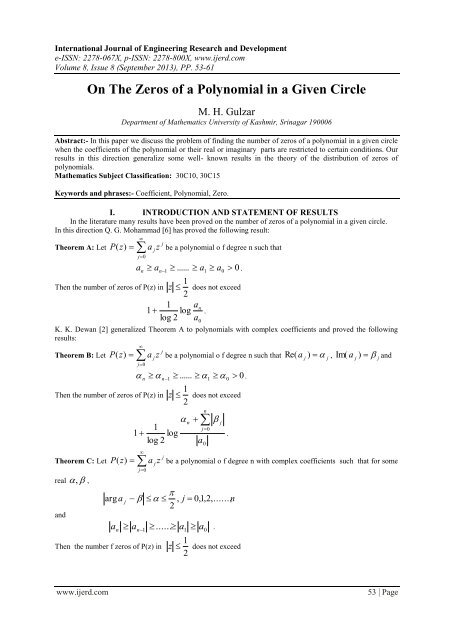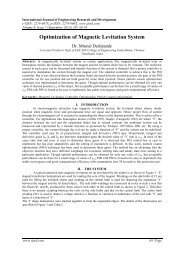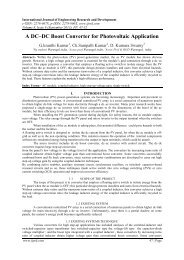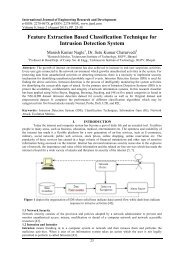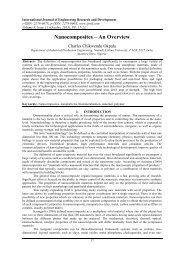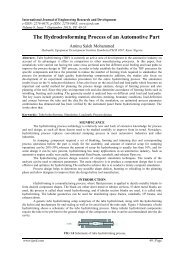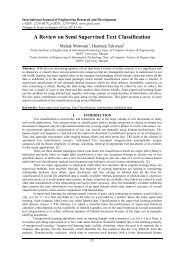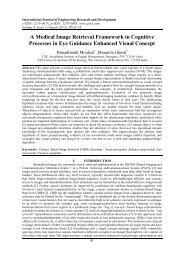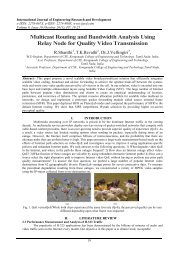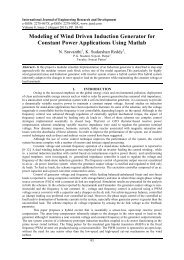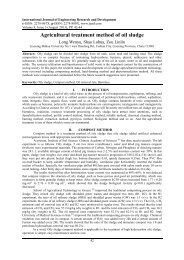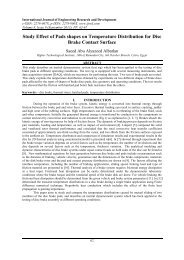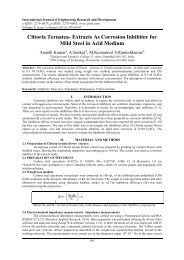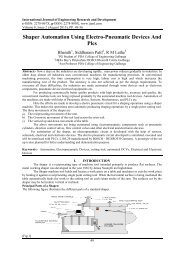�
Create successful ePaper yourself
Turn your PDF publications into a flip-book with our unique Google optimized e-Paper software.
International Journal of Engineering Research and Development<br />
e-ISSN: 2278-067X, p-ISSN: 2278-800X, www.ijerd.com<br />
Volume 8, Issue 8 (September 2013), PP. 53-61<br />
On The Zeros of a Polynomial in a Given Circle<br />
M. H. Gulzar<br />
Department of Mathematics University of Kashmir, Srinagar 190006<br />
Abstract:- In this paper we discuss the problem of finding the number of zeros of a polynomial in a given circle<br />
when the coefficients of the polynomial or their real or imaginary parts are restricted to certain conditions. Our<br />
results in this direction generalize some well- known results in the theory of the distribution of zeros of<br />
polynomials.<br />
Mathematics Subject Classification: 30C10, 30C15<br />
Keywords and phrases:- Coefficient, Polynomial, Zero.<br />
I. INTRODUCTION AND STATEMENT OF RESULTS<br />
In the literature many results have been proved on the number of zeros of a polynomial in a given circle.<br />
In this direction Q. G. Mohammad [6] has proved the following result:<br />
Theorem A: Let <br />
( )<br />
j<br />
a z P be a polynomial o f degree n such that<br />
j<br />
j0<br />
z<br />
an an<br />
1<br />
Then the number of zeros of P(z) in<br />
a<br />
1<br />
...... a1<br />
0<br />
1<br />
<br />
2<br />
1 an log<br />
log 2 a<br />
0<br />
z does not exceed<br />
.<br />
0<br />
K. K. Dewan [2] generalized Theorem A to polynomials with complex coefficients and proved the following<br />
results:<br />
Theorem B: Let <br />
j<br />
P( z)<br />
a be a polynomial o f degree n such that a j ) j Im( a ) and<br />
Then the number of zeros of P(z) in<br />
j z<br />
j0<br />
n n1<br />
...... 1<br />
0<br />
1 <br />
1<br />
log 2<br />
1<br />
<br />
2<br />
www.ijerd.com 53 | Page<br />
.<br />
0<br />
z does not exceed<br />
log<br />
<br />
<br />
n <br />
j0<br />
a<br />
n<br />
0<br />
<br />
j<br />
.<br />
.<br />
Re( , j j<br />
Theorem C: Let <br />
j<br />
P( z)<br />
a be a polynomial o f degree n with complex coefficients such that for some<br />
real , ,<br />
and<br />
<br />
j0<br />
j z<br />
<br />
arg a j , j 0,<br />
1,<br />
2,......,<br />
n<br />
2<br />
an an<br />
1 ......<br />
a1<br />
a0<br />
Then the number f zeros of P(z) in<br />
.<br />
1<br />
<br />
2<br />
z does not exceed
1<br />
log 2<br />
log<br />
a<br />
n 1<br />
n (cos sin 1)<br />
2sin<br />
<br />
j 0<br />
<br />
<br />
<br />
a<br />
0<br />
On The Zeros of a Polynomial in a Given Circle<br />
The above results were further generalized by researchers in various ways.<br />
M. H. Gulzar[4,5,6] proved the following results:<br />
Theorem D: Let <br />
j<br />
P( z)<br />
a be a polynomial o f degree n such that a j ) j<br />
j z<br />
j0<br />
n n1<br />
, k<br />
1<br />
...... ....... <br />
www.ijerd.com 54 | Page<br />
a<br />
j<br />
.<br />
1<br />
Im( a ) and<br />
Re( , j j<br />
for k 1, 0 <br />
1,<br />
0 n.<br />
Then the number of zeros of P(z) in 1 0 , z does not exceed<br />
1<br />
log<br />
1<br />
log<br />
<br />
n n ( k 1)(<br />
) 2<br />
0<br />
a0<br />
<br />
( 0 0 ) 2<br />
j<br />
j0<br />
.<br />
Theorem E: Let <br />
P( z)<br />
a<br />
j<br />
be a polynomial o f degree n such that a j ) j Im( a ) and<br />
j z<br />
j0<br />
n n1<br />
...... 1<br />
<br />
0 ,<br />
0<br />
,<br />
Re( , j j<br />
for some 0, 0 <br />
1,<br />
,then the number f zeros of P(z) in z ,<br />
0 1,<br />
does not exceed<br />
2<br />
n<br />
1<br />
log<br />
1<br />
log<br />
<br />
n <br />
( 0 0 ) 2<br />
0<br />
a0<br />
2<br />
j<br />
j0<br />
.<br />
Theorem F: Let <br />
P( z)<br />
a<br />
j<br />
be a polynomial o f degree n with complex coefficients such that for some<br />
real , ,<br />
and<br />
<br />
j0<br />
j z<br />
<br />
arg a j , j 0,<br />
1,<br />
2,......,<br />
n<br />
2<br />
<br />
,<br />
an an<br />
1 ......<br />
a1<br />
a0<br />
for some 0,<br />
,then the number of zeros of P(z) in z ,<br />
0 1,<br />
does not exceed<br />
n 1<br />
n )(cos sin 1)<br />
2sin<br />
<br />
j 1<br />
<br />
<br />
<br />
( a<br />
1<br />
log<br />
1<br />
log<br />
<br />
a0<br />
a j a0<br />
(cos<br />
sin 1)<br />
.<br />
The aim of this paper is to find a bound for the number of zeros of P(z) in a circle of radius not<br />
necessarily less than 1. In fact , we are going to prove the following results:<br />
Theorem 1: Let <br />
( )<br />
j<br />
a z P be a polynomial of degree n such that a j ) j Im( a ) and<br />
j<br />
j0<br />
z<br />
n n1<br />
, k<br />
1<br />
...... ....... <br />
1<br />
n<br />
Re( , j j<br />
0<br />
,<br />
n
On The Zeros of a Polynomial in a Given Circle<br />
for k 1, 0 <br />
1,<br />
0 n.<br />
Then the number of zeros of P(z) in z ( R 0,<br />
c 1)<br />
does not exceed<br />
and<br />
R<br />
1<br />
log<br />
log c<br />
1<br />
log<br />
log c<br />
a<br />
0<br />
n1<br />
[<br />
n n<br />
<br />
0<br />
www.ijerd.com 55 | Page<br />
0<br />
0<br />
R<br />
c<br />
0<br />
n<br />
<br />
j0<br />
( k 1)(<br />
) 2<br />
<br />
( ) 2 ]<br />
a<br />
0<br />
for R 1<br />
n<br />
n n ( k 1)(<br />
) <br />
( 0 0 ) 0 0 2<br />
j1<br />
R[<br />
]<br />
1<br />
<br />
a<br />
for R 1.<br />
Remark 1: Taking R=1 and c in Theorem 1, it reduces to Theorem D .<br />
If the coefficients a j are real i.e. j 0,<br />
j<br />
, then we get the following result from Theorem 1:<br />
Corollary 1: Let <br />
j<br />
P( z)<br />
a be a polynomial o f degree n such that<br />
j z<br />
j0<br />
an an<br />
1 a<br />
, ka<br />
a<br />
1<br />
...... ....... a a<br />
for k 1, 0 <br />
1,<br />
0 n.<br />
Then the number of zeros of P(z) in z ( R 0,<br />
c 1)<br />
does not exceed<br />
and<br />
1 R<br />
log<br />
log c<br />
1<br />
log<br />
log c<br />
a<br />
0<br />
n1<br />
[ a<br />
n<br />
a<br />
n<br />
( k 1)(<br />
a<br />
<br />
a<br />
0<br />
a<br />
0<br />
<br />
) 2 a<br />
0<br />
0<br />
1<br />
<br />
( a<br />
0<br />
for R 1<br />
R[<br />
a a ( k 1)(<br />
a a ) a <br />
( a<br />
n<br />
n<br />
a<br />
<br />
<br />
0<br />
0<br />
,<br />
R<br />
c<br />
a )]<br />
a<br />
for R 1.<br />
Applying Theorem 1 to the polynomial –iP(z) , we get the following result:<br />
Theorem 2: Let <br />
j<br />
P( z)<br />
a be a polynomial o f degree n such that a j ) j<br />
j z<br />
j0<br />
n n1<br />
, k<br />
1<br />
...... ....... <br />
1<br />
0<br />
0<br />
)]<br />
Re( , j j<br />
0<br />
,<br />
j<br />
j<br />
Im( a ) and<br />
for k 1, 0 <br />
1,<br />
0 n.<br />
Then the number of zeros of P(z) in z ( R 0,<br />
c 1)<br />
does not exceed<br />
and<br />
R<br />
1<br />
log<br />
log c<br />
1<br />
log<br />
log c<br />
a<br />
0<br />
n1<br />
[<br />
n n<br />
<br />
0<br />
0<br />
0<br />
R<br />
c<br />
0<br />
n<br />
<br />
j0<br />
( k 1)(<br />
) 2 <br />
( ) 2 ]<br />
a<br />
0<br />
for R 1<br />
n<br />
n n ( k 1)(<br />
<br />
) 0 0 <br />
( 0 0 ) 2<br />
j1<br />
R[<br />
]<br />
a<br />
j<br />
j
Taking n in Theorem 1, we get the following result :<br />
On The Zeros of a Polynomial in a Given Circle<br />
for R 1.<br />
Corollary 2: Let <br />
j<br />
P( z)<br />
a be a polynomial o f degree n such that a j ) j<br />
j z<br />
j0<br />
n n1<br />
....... 1<br />
0<br />
k ,<br />
Im( a ) and<br />
Re( , j j<br />
for k 1, 0 <br />
1,<br />
0 n.<br />
Then the number of zeros of P(z) in z ( R 0,<br />
c 1)<br />
does not exceed<br />
and<br />
R<br />
1<br />
log<br />
log c<br />
1<br />
log<br />
log c<br />
n1<br />
a<br />
0<br />
0<br />
0<br />
0<br />
www.ijerd.com 56 | Page<br />
0<br />
n<br />
<br />
j0<br />
[ k(<br />
) 2<br />
<br />
( ) 2 ]<br />
n<br />
n<br />
a<br />
0<br />
for R 1<br />
R[<br />
k(<br />
) <br />
( ) 2 ]<br />
n n 0 0 0 <br />
j0<br />
a<br />
n<br />
j<br />
j<br />
R<br />
c<br />
for R 1.<br />
Theorem 3: Let <br />
j<br />
P( z)<br />
a be a polynomial o f degree n such that a j ) j<br />
j z<br />
j0<br />
n n1<br />
...... 1<br />
<br />
0 ,<br />
Im( a ) and<br />
Re( , j j<br />
for some , 0 1,<br />
,then the number of zeros of P(z) in z ( R 0,<br />
c 1)<br />
, does not exceed<br />
and<br />
R<br />
1<br />
log<br />
log c<br />
1<br />
log<br />
log c<br />
n1<br />
a<br />
0<br />
0<br />
0<br />
0<br />
R<br />
c<br />
0<br />
n<br />
<br />
j0<br />
[ <br />
( ) 2<br />
2 ]<br />
n<br />
n<br />
a<br />
0<br />
for R 1<br />
R[<br />
<br />
( ) 2 ]<br />
1<br />
<br />
n n 0 0 0 <br />
j0<br />
a<br />
for R 1.<br />
Remark 2: Taking R=1 and c in Theorem 3, it reduces to Theorem E .<br />
If the coefficients a j are real i.e. j 0,<br />
j<br />
, then we get the following result from Theorem 3:<br />
Corollary 3: Let <br />
j<br />
( ) a z P be a polynomial o f degree n such that<br />
<br />
j0<br />
j z<br />
<br />
,<br />
an an<br />
1 ...... a1<br />
a0<br />
for some , 0 1.<br />
Then the number of zeros of P(z) in z ( R 0,<br />
c 1)<br />
, does not exceed<br />
1 R<br />
log<br />
log c<br />
n1<br />
[ a<br />
n<br />
a<br />
n<br />
a<br />
0<br />
<br />
( a<br />
0<br />
R<br />
c<br />
a ) 2 a<br />
0<br />
0<br />
]<br />
n<br />
j<br />
j<br />
for R<br />
1
and<br />
1<br />
log<br />
log c<br />
a<br />
0<br />
R[<br />
a a <br />
( a<br />
n<br />
a<br />
On The Zeros of a Polynomial in a Given Circle<br />
www.ijerd.com 57 | Page<br />
0<br />
n<br />
0<br />
a ) a<br />
Applying Theorem 3 to the polynomial –iP(z) , we get the following result:<br />
Theorem 4: Let <br />
P( z)<br />
a<br />
j<br />
be a polynomial o f degree n such that a j ) j<br />
j z<br />
j0<br />
n n1<br />
...... 1<br />
<br />
0 ,<br />
0<br />
0<br />
]<br />
Im( a ) and<br />
Re( , j j<br />
for some 0, 0 1.<br />
Then the number of zeros of P(z) in z ( R 0,<br />
c 1)<br />
, does not exceed<br />
and<br />
R<br />
1<br />
log<br />
log c<br />
1<br />
log<br />
log c<br />
n1<br />
a<br />
0<br />
0<br />
0<br />
0<br />
0<br />
R<br />
c<br />
n<br />
<br />
j0<br />
[ <br />
( ) 2 2 ]<br />
n<br />
n<br />
a<br />
0<br />
for R 1<br />
R[<br />
<br />
( ) 2 ]<br />
n n 0 0 0 <br />
j0<br />
for 1<br />
Taking ( 1)<br />
, k 1<br />
in Corollary 3 , we get the following result:<br />
k n<br />
a<br />
R .<br />
Corollary 4: Let <br />
j<br />
P( z)<br />
a be a polynomial o f degree n such that a j ) j<br />
j z<br />
j0<br />
n n1<br />
...... 1<br />
<br />
0<br />
k ,<br />
n<br />
j<br />
j<br />
Im( a ) and<br />
Re( , j j<br />
for some , 0 1.<br />
Then the number of zeros of P(z) in z ( R 0,<br />
c 1)<br />
, does not exceed<br />
and<br />
R<br />
1<br />
log<br />
log c<br />
1<br />
log<br />
log c<br />
n1<br />
a<br />
0<br />
0<br />
0<br />
0<br />
0<br />
R<br />
c<br />
n<br />
<br />
j0<br />
[ k(<br />
) <br />
( ) 2<br />
2 ]<br />
n<br />
n<br />
a<br />
0<br />
for R 1<br />
R[<br />
k(<br />
) <br />
( ) 2 ]<br />
n n<br />
0 0 0 <br />
j0<br />
a<br />
n<br />
for R 1.<br />
Theorem 5: Let <br />
j<br />
( ) a z P be a polynomial o f degree n such that<br />
<br />
j0<br />
j z<br />
<br />
an an<br />
1 ...... a1<br />
a0<br />
for some , 0 1.<br />
Then the number of zeros of P(z) in z ( R 0,<br />
c 1)<br />
, does not exceed<br />
1 1 n<br />
log [ R<br />
log c<br />
a<br />
0<br />
1<br />
{( a )(cos<br />
sin 1)<br />
<br />
(cos<br />
sin 1)<br />
2<br />
}]<br />
n<br />
R<br />
c<br />
0<br />
j<br />
j<br />
0
and<br />
On The Zeros of a Polynomial in a Given Circle<br />
for R 1<br />
1 1<br />
log [ a0<br />
R{(<br />
an<br />
)(cos<br />
sin 1)<br />
<br />
a0<br />
(cos<br />
sin 1)<br />
a0<br />
}]<br />
log c a<br />
0<br />
for R 1.<br />
For different values of the parameters k , , in the above results, we get many other interesting results.<br />
II. LEMMAS<br />
For the proofs of the above results we need the following results:<br />
Lemma 1: If f(z) is analytic in z R ,but not identically zero, f(0) 0 and<br />
f ( ak<br />
) 0,<br />
k 1,<br />
2,......,<br />
n , then<br />
1 <br />
2<br />
2<br />
n<br />
i<br />
log f (Re d<br />
log f ( 0)<br />
log<br />
0<br />
j1 a j<br />
Lemma 1 is the famous Jensen’s theorem (see page 208 of [1]).<br />
Lemma 2: If f(z) is analytic and ( z)<br />
M(<br />
r)<br />
does not exceed<br />
www.ijerd.com 58 | Page<br />
R<br />
.<br />
r<br />
f in z r , then the number of zeros of f(z) in z , c 1<br />
c<br />
1 M ( r)<br />
log .<br />
log c f ( 0)<br />
Lemma 2 is a simple deduction from Lemma 1.<br />
Lemma 3: Let <br />
( )<br />
j<br />
a z P be a polynomial o f degree n with complex coefficients such that for some<br />
<br />
j0<br />
j z<br />
a j<br />
<br />
2<br />
a j j 1<br />
ta a t a a ) cos<br />
( t a a ) sin .<br />
real , , arg , 0 j n,<br />
and a , 0 j n,<br />
then any t>0,<br />
j j1<br />
( j j1<br />
j j1<br />
Lemma 3 is due to Govil and Rahman [4].<br />
III. PROOFS OF THEOREMS<br />
Proof of Theorem 1: Consider the polynomial<br />
F(z) =(1-z)P(z)<br />
1 z)(<br />
a<br />
n<br />
z a<br />
n1<br />
z ...... a z a )<br />
( n n<br />
1<br />
1 0<br />
n1<br />
an<br />
z an<br />
an1<br />
a<br />
z<br />
n<br />
n1<br />
n<br />
( ) z ...... ( a a ) z a<br />
a<br />
0<br />
[( k<br />
<br />
n<br />
( ) z ...... ( ) z<br />
1<br />
n<br />
n1<br />
) ( k 1)<br />
] z<br />
[( <br />
) ( )] z i<br />
1<br />
<br />
For z R , we have by using the hypothesis<br />
F<br />
n1<br />
( z)<br />
an<br />
R a0<br />
0<br />
0<br />
+<br />
0<br />
<br />
<br />
1<br />
( <br />
n<br />
<br />
j0<br />
0<br />
1<br />
j<br />
1<br />
<br />
( <br />
0<br />
2<br />
j1<br />
<br />
) z<br />
) z<br />
1<br />
1<br />
j<br />
......<br />
R<br />
<br />
R <br />
<br />
R k<br />
<br />
n<br />
1<br />
n n1<br />
...... 1<br />
1<br />
<br />
1<br />
( k 1)<br />
<br />
R <br />
1 <br />
2<br />
R ...... 1<br />
0<br />
R ( 1<br />
) 0<br />
R<br />
<br />
n<br />
<br />
j1<br />
( <br />
<br />
j<br />
j1<br />
)
and<br />
On The Zeros of a Polynomial in a Given Circle<br />
n1<br />
n<br />
an R a0<br />
R [ n <br />
n1<br />
......<br />
<br />
1<br />
<br />
k<br />
<br />
1<br />
<br />
<br />
<br />
( k 1)<br />
<br />
1 2 ...... 1 0 ( 1 ) 0 0 2<br />
n<br />
<br />
<br />
n <br />
<br />
]<br />
n1<br />
n<br />
an R a0<br />
R [ n ( k 1)(<br />
<br />
<br />
) <br />
( 0<br />
<br />
0)<br />
0<br />
0<br />
n<br />
2<br />
1<br />
<br />
1<br />
n<br />
j<br />
j<br />
]<br />
n1<br />
R n <br />
n ( k 1)(<br />
<br />
<br />
<br />
[ ) <br />
( <br />
) 2<br />
www.ijerd.com 59 | Page<br />
0<br />
0<br />
0<br />
<br />
n<br />
2 j<br />
0<br />
1<br />
j1<br />
j<br />
<br />
] for R 1<br />
F(<br />
z)<br />
a R[<br />
( k 1)(<br />
) <br />
( ) 2 ]<br />
0<br />
n n<br />
<br />
for 1<br />
Therefore , by Lemma 3, it follows that the number of zeros of F(z) and hence<br />
R<br />
c<br />
P(z) in z ( R 0,<br />
c 0)<br />
does not exceed<br />
and<br />
1<br />
log<br />
log c<br />
R<br />
1<br />
log<br />
log c<br />
a<br />
0<br />
n1<br />
[<br />
n n<br />
<br />
0<br />
0<br />
0<br />
0<br />
0<br />
0<br />
R .<br />
0<br />
0<br />
n<br />
<br />
j0<br />
( k 1)(<br />
<br />
) 2<br />
<br />
( <br />
) 2 <br />
0<br />
a<br />
for R 1<br />
n<br />
n <br />
n ( k 1)(<br />
<br />
) <br />
( 0 <br />
0 ) 0 0 2<br />
j1<br />
R[<br />
<br />
That proves Theorem 1.<br />
Proof of Theorem 3: Consider the polynomial<br />
F(z) =(1-z)P(z)<br />
n<br />
n1<br />
1 z)(<br />
a z a z ...... <br />
( n n<br />
1<br />
a1z<br />
a0<br />
n1<br />
an<br />
z an<br />
an1<br />
n<br />
( ) z ...... ( a a ) z a<br />
n1<br />
n<br />
an<br />
z a0<br />
z n n1<br />
1<br />
a<br />
)<br />
0<br />
0<br />
for R 1.<br />
n<br />
( ) z ...... ( ) z<br />
n<br />
<br />
j0<br />
j<br />
[(<br />
<br />
) ( <br />
)] z i ( ) z .<br />
1<br />
For z R , we have by using the hypothesis<br />
F<br />
n1<br />
( z)<br />
an<br />
R a0<br />
0<br />
0<br />
0<br />
j<br />
j1<br />
2<br />
1<br />
2<br />
j<br />
n<br />
<br />
j1<br />
n<br />
n<br />
2<br />
+ R <br />
<br />
R <br />
R R<br />
+ ( 1 <br />
) 0 R ( j j<br />
j0<br />
n<br />
n n<br />
1 ...... 2 1<br />
1 0<br />
1<br />
) R<br />
n1<br />
R n 0<br />
<br />
n <br />
n1<br />
[ ......<br />
<br />
<br />
<br />
<br />
n<br />
<br />
j0<br />
( 1 <br />
) 2 ]<br />
0<br />
j<br />
j<br />
2<br />
1<br />
1<br />
0<br />
j<br />
j<br />
j
and<br />
On The Zeros of a Polynomial in a Given Circle<br />
n1<br />
R [ <br />
( ) 2<br />
2 ] for R 1<br />
n<br />
n<br />
0<br />
F(<br />
z)<br />
a R[<br />
<br />
( ) 2 ] for R 1.<br />
0<br />
n<br />
n<br />
0<br />
0<br />
www.ijerd.com 60 | Page<br />
0<br />
0<br />
0<br />
n<br />
<br />
j0<br />
n<br />
<br />
j 0<br />
Therefore , by Lemma 2, it follows that the number of zeros of F(z) and hence<br />
R<br />
c<br />
P(z) in z ( R 0,<br />
c 0)<br />
does not exceed<br />
and<br />
R<br />
1<br />
log<br />
log c<br />
1<br />
log<br />
log c<br />
n1<br />
a<br />
0<br />
0<br />
0<br />
0<br />
0<br />
j<br />
j<br />
n<br />
<br />
j0<br />
[ <br />
( ) 2<br />
2 ]<br />
n<br />
n<br />
a<br />
0<br />
for R 1<br />
R[<br />
<br />
( ) 2 ]<br />
That proves Theorem 3.<br />
Proof of Theorem 5: Consider the polynomial<br />
F(z) =(1-z)P(z)<br />
n<br />
n1<br />
1 z)(<br />
a z a z ...... <br />
( n n<br />
1<br />
a1z<br />
a0<br />
n1<br />
an<br />
z an<br />
an1<br />
n n 0 0 0 <br />
j0<br />
n<br />
( ) z ...... ( a a ) z a<br />
n1<br />
n<br />
an<br />
z a0<br />
z an<br />
an1<br />
[( a 1 <br />
a0<br />
) ( a0<br />
a0<br />
)] z .<br />
a<br />
1<br />
)<br />
0<br />
0<br />
for R 1.<br />
n<br />
( ) z ...... ( a a ) z<br />
For z R , we have by using the hypothesis and Lemma 3<br />
F<br />
n1<br />
( z)<br />
an<br />
R a0<br />
<br />
+ ( 1<br />
)<br />
R<br />
0<br />
n<br />
n<br />
2<br />
+ R a a R a a R a a R<br />
n n<br />
1 ...... 2 1 1 0<br />
n1<br />
n<br />
a n R a0<br />
R [(<br />
an<br />
an1<br />
) cos<br />
( an<br />
an1<br />
) sin<br />
]<br />
...... [( a<br />
[( a<br />
1<br />
2<br />
<br />
a<br />
0<br />
a ) cos<br />
( a<br />
1<br />
) cos<br />
( a<br />
1<br />
2<br />
<br />
a<br />
a ) sin ]<br />
R<br />
0<br />
1<br />
) sin ]<br />
R<br />
2<br />
2<br />
1<br />
( 1<br />
) a<br />
n1<br />
R [( an<br />
)(cos<br />
sin<br />
1)<br />
<br />
0<br />
(cos<br />
sin<br />
1)<br />
2a0<br />
]<br />
for R 1<br />
and<br />
a0 R[(<br />
an<br />
)(cos<br />
sin<br />
1)<br />
<br />
a0<br />
(cos<br />
sin<br />
1)<br />
a0<br />
]<br />
for R 1.<br />
Hence , by Lemma 2, it follows that the number of zeros of F(z) and therefore P(z)<br />
R<br />
in z ( R 0,<br />
c 0)<br />
does not exceed<br />
c<br />
1 1 n1<br />
log [ R {( an<br />
)(cos<br />
sin 1)<br />
<br />
0 (cos<br />
sin 1)<br />
2<br />
0 }]<br />
log c<br />
a<br />
0<br />
0<br />
n<br />
2<br />
j<br />
R<br />
2<br />
j<br />
R<br />
n
and<br />
On The Zeros of a Polynomial in a Given Circle<br />
for R 1<br />
1 1<br />
log [ a0<br />
R{(<br />
an<br />
)(cos<br />
sin 1)<br />
<br />
a0<br />
(cos<br />
sin 1)<br />
a0<br />
}]<br />
log c a<br />
0<br />
That completes the proof of Theorem 5.<br />
for R 1.<br />
REFERENCES<br />
[1]. L.V.Ahlfors, Complex Analysis, 3 rd edition, Mc-Grawhill<br />
[2]. K. K. Dewan, Extremal Properties and Coefficient estimates for Polynomials with restricted Zeros and<br />
on location of Zeros of Polynomials, Ph.D. Thesis, IIT Delhi, 1980.<br />
[3]. N. K. Govil and Q. I. Rahman, On the Enestrom- Kakeya Theorem, Tohoku Math. J. 20(1968),126-<br />
136.<br />
[4]. M. H. Gulzar, On the Zeros of a Polynomial inside the Unit Disk, IOSR Journal of Engineering, Vol.3,<br />
Issue 1(Jan.2013) IIV3II, 50-59.<br />
[5]. M. H. Gulzar, On the Number of Zeros of a Polynomial in a Prescribed Region, Research Journal of<br />
Pure Algebra-2(2), 2012, 35-49.<br />
[6]. M. H. Gulzar, On the Zeros of a Polynomial, International Journal of Scientific and Research<br />
Publications, Vol. 2, Issue 7,July 2012,1-7.<br />
[7]. Q. G. Mohammad, On the Zeros of Polynomials, Amer. Math. Monthly 72(1965), 631-633.<br />
www.ijerd.com 61 | Page


